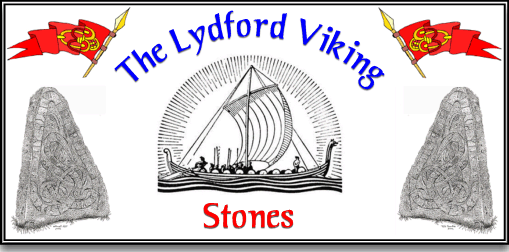
Standing in the stroll of the field next to the church stands a large, incised stone with Viking style runic carving, this is the ‘Rune Stone’. Just across the road stands a pillar of granite with a sculpture of a shield and axe mounted on it, this is the ‘Saxon Stone’. As you come down the main village street there is a small lane called ‘Silver Street’ leading off to the left. So what have Vikings, Saxons, and Silver to do with Lydford? To find the answer one has to travel back to Saxon times when Lydford was established as a Saxon Burgh. The origins of the burgh lies rooted in the defensive measures taken by Alfred and his son Edward against the Danes in Wessex. Sir Frank Stenton (1971 p.264) describes the scheme where basically where no village was more than 20 miles from a fortress, which formed a unit in a network of national defences. The other feature of the burgh was the establishment of a coin mint which it is thought was located somewhere in ‘Silver Street’ (hence its name). Here coins, known as ‘Lydford Pennies’ were minted of which there are some good examples hanging in the nearby Castle Inn. Many more examples can be found in various Scandinavian museums and here lies a clue to the Viking involvement in Lydford. Coin production was carried out between the reign of Etheldred II, Cnut, Harold I and Edward the confessor. It is generally assumed that the coins were used to pay the tax exacted by the Vikings known as Danegeld. This was a payment to supposedly ensure peace and during Aethelred’s reign it is estimated that in 991 alone, he paid 22,000 pounds weight of gold and silver to the Danes (Laing 1979 p.139). This is the reason that there are more examples of the Lydford Penny in Scandinavia than Britain, the Danegeld was being taken back to the Viking lands.
However, it seems that the protection money paid to the Vikings was not enough and as the Anglo Saxon Chronicles testify the Vikings paid a visit to Lydford in the year 997, where they “turned into the mouth of the Tamar, and then went up until they came to Lydford, and burned and killed everything they met” (Swanson 2003 p.131).
So there we have the purpose of the commemorative stones – the Viking raid on Lydford. The ‘Rune Stone’ was commissioned to mark the 1,000th anniversary of the 997 attack. The stone was made by a stonemason called ‘Eric the Red’ and when it was unveiled a sacrifice of mead was poured over it at the celebrations of the Viking’s 97 festival on the 27th of July.

The other stone also commemorates the Viking raid and was erected in 1990 by the Lydford Women’s Institute. The plaque reads: “Llydanforde – SITE OF DANISH SAXON CONFLICT 997 AD – TO COMMEMORATE THE 70TH ANNIVERSARY – OF LYDFORD W.I. 1920 – 1970.”

Reading List.
Laing, L & J. 1979 Anglo Saxon England. Book Club Associates, Thetford.
Stenton, F. Sir 1971 Anglo Saxon England, Oxford University Press, Oxford.
Swanson, M. 2003 The Anglo-Saxon Chronicles, Phoenix Press, London.
 Legendary Dartmoor The many aspects past and present of Dartmoor
Legendary Dartmoor The many aspects past and present of Dartmoor

Hi Tim, Can I please use the “inked in red” picture here please for my website ? It’ll complement recent pictures I have taken. Many thanks.
Kind Regards,
Steve